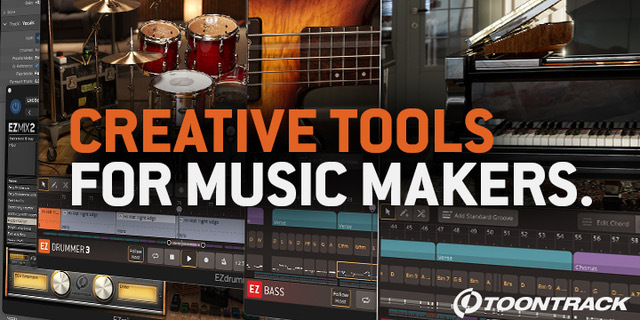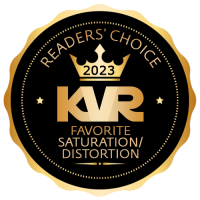Product Reviews by KVR Members
All reviews by learjeff
Review Something or Find Reviews
Grand Piano
Reviewed By learjeff [all]
March 19th, 2005
Version reviewed: 1.1 on Windows
EVM Grand Piano sounds like it's based on a good set of samples. Unfortunately, it won't satisfy a piano player, due to three very simple (and therefore frustrating) drawbacks. These should be pretty easily remediable.
1) It's limited to 8 notes playing at once. Furthermore, when it steals voices, it steals the oldest voice. For piano, it's best never to steal the lowest voice. 16 voices is pretty much the minimum but insufficient for striding styles. 32 is reasonable, though some pieces with sweeping sustained runs can use more than that.
2) The decay and sustain controls are wrong for an instrument like piano, which should have decay and release. The "decay" control affects both decay and release, and the sustain works the way it would on a typical synthesizer. On all real pianos, the sustain level is zero. However, since both decay and release are controlled by one knob, it's necessary to set sustain high and release low (so that the notes don't continue to ring after you release a key). It's impossible to get a natural sounding note. Replace the sustain knob with a release knob and bingo this is fixed.
3) The same sample is used regardless of velocity, leading to very unnatural dynamics. On a real piano, softer notes are also much less bright. With a single sample, it's necessary to use a velocity-sensitive filter. Only pieces where all notes are played loud will sound good on this piano (like boogie-woogie).
The presence switch turns the stereo effect on and off. It's a subtle effect, but when summed to mono causes unnatural coloration so it's good to be able to turn it off.
I've never seen a real piano with a fancy GUI, so I don't see any reason why a piano softsynth needs one. The GUI (once the controls are fixed to do the right things) is perfectly reasonable for the instrument. (Though, it is odd that the volume control is labeled "Input 2".)Read Review
1) It's limited to 8 notes playing at once. Furthermore, when it steals voices, it steals the oldest voice. For piano, it's best never to steal the lowest voice. 16 voices is pretty much the minimum but insufficient for striding styles. 32 is reasonable, though some pieces with sweeping sustained runs can use more than that.
2) The decay and sustain controls are wrong for an instrument like piano, which should have decay and release. The "decay" control affects both decay and release, and the sustain works the way it would on a typical synthesizer. On all real pianos, the sustain level is zero. However, since both decay and release are controlled by one knob, it's necessary to set sustain high and release low (so that the notes don't continue to ring after you release a key). It's impossible to get a natural sounding note. Replace the sustain knob with a release knob and bingo this is fixed.
3) The same sample is used regardless of velocity, leading to very unnatural dynamics. On a real piano, softer notes are also much less bright. With a single sample, it's necessary to use a velocity-sensitive filter. Only pieces where all notes are played loud will sound good on this piano (like boogie-woogie).
The presence switch turns the stereo effect on and off. It's a subtle effect, but when summed to mono causes unnatural coloration so it's good to be able to turn it off.
I've never seen a real piano with a fancy GUI, so I don't see any reason why a piano softsynth needs one. The GUI (once the controls are fixed to do the right things) is perfectly reasonable for the instrument. (Though, it is odd that the volume control is labeled "Input 2".)Read Review
ORGANized trio
Reviewed By learjeff [all]
December 20th, 2004
Version reviewed: 3.0 on Windows
I'm a Native Instruments B4 player. As it's been too long since I've played an actual Hammond, I'll have to compare ORGANized Trio to NIB4 more than the real thing, except for a few details I happen to remember well.
The good news is that it's comparable. Other cheap or free VSTi's I've tried in the past don't quite reach that level.
Overall, it's an extremely lively and playable Hammond clone, and reasonably authentic as well. It correctly implements foldback on both ends of the keyboard. For example, as you go lower on the keyboard, at some point the 16' drawbar tone is replaced by the 8' drawbar tone, because with the 91 tonewheel set of all but the earliest Hammond models, there weren't enough tonewheels to go lower. This happens for other drawbars as well, and at the top of the keyboard too.
The scanner chorus/vibrato sounds very realistic as well. Yes, the vibrato is cheesy sounding -- just as it is on a real Hammond! The chorus is very lifelike and musically performs the function Hammond players love it for. OT's chorus is a little stronger than NIB4's: the C1 OT setting sounds like NIB4's C2, and OT's C2 sounds like NIB4's C3. I don't miss the subtler C1 on NIB4, though some players might.
I find the drawbar sound itself to be quite good, although there are too many overtones in the 16', and this interferes with the clarity of bell-like tones such as 80-000-0008. Instead, it sounds like an Hammond that's in need of a tune-up (a bit too much "leakage"). Some folks like their Hammonds that way.
There's another minor discrepancy between OT and a Hammond or NIB4. In the latter, the sounds all come from the same set of tonewheels. The 16' drawbar sound for C4 is the same sound as the 8' drawbar sound for C3. This is not the case for OT, where each drawbar has its individual tone. However, except for the 16' drawbar, they're all similar enough that this isn't an issue.
Another subtle discrepancy is that OT doesn't emulate Hammond "tone robbing". When you play a lot of keys at once on a Hammond, the total volume is considerably less than the sum of all the individual notes, due to the fact that they're sharing the same tonewheels and the way the summing network is designed. However, I find this less annoying with OT than I do on most synthesizer "B3" settings -- not sure why.
One of the acid tests for a tonewheel clone is a palm slide with fast Leslie and chorus on. On a Hammond, you get a lovely bubbling sound -- something that synths and older clones like Oberheim OB3 just don't get. Well, it sounds just great in OT, much to my delight.
Overall, the sound of OT is brighter than NIB4 (regardless of NIB4 tonewheel set). However, I susepct it's within the range of differences we find from instrument to instrument on real Hammond organs -- or at least, not too far outside that range.
I find the Leslie tube amp sim to be useful but not as good as NIB4's. I wasn't quite able to get the classic heavily overdriven Leslie "grind" sound on the low end that I can with NIB4 (and I don't find the NIB4's tube sim to be quite stellar, either). Perhaps with more fiddling I'd find some magic settings.
The Leslie rotating speaker sim is good, although not quite as rich in imagery as other rotating speaker sims, such as NIB4's or the one built into a Genesis3 guitar amp/speaker modeler. Nonethelss, it's quite useful and playable.
Most features are nicely configurable, including the ability to select MIDI controllers for popular functions on the GUI. More MIDI controller configurability would be nice, so that I could set it up to respond the same as NIB4.
I was unable to make it respond to MIDI Expression (cc 11) to control the swell pedal. No doubt with MIDIOX and the documentation I could get that sorted out, though.
To sum up, I don't think this would satisfy a die-hard vintage Hammond lover. Long-time players probably wouldn't be able to use identical drawbar settings from their favorite B3's. But for someone who's looking for a great Hammond-like sound on a budget, Organized Trio is an excellent solution and a prize.Read Review
The good news is that it's comparable. Other cheap or free VSTi's I've tried in the past don't quite reach that level.
Overall, it's an extremely lively and playable Hammond clone, and reasonably authentic as well. It correctly implements foldback on both ends of the keyboard. For example, as you go lower on the keyboard, at some point the 16' drawbar tone is replaced by the 8' drawbar tone, because with the 91 tonewheel set of all but the earliest Hammond models, there weren't enough tonewheels to go lower. This happens for other drawbars as well, and at the top of the keyboard too.
The scanner chorus/vibrato sounds very realistic as well. Yes, the vibrato is cheesy sounding -- just as it is on a real Hammond! The chorus is very lifelike and musically performs the function Hammond players love it for. OT's chorus is a little stronger than NIB4's: the C1 OT setting sounds like NIB4's C2, and OT's C2 sounds like NIB4's C3. I don't miss the subtler C1 on NIB4, though some players might.
I find the drawbar sound itself to be quite good, although there are too many overtones in the 16', and this interferes with the clarity of bell-like tones such as 80-000-0008. Instead, it sounds like an Hammond that's in need of a tune-up (a bit too much "leakage"). Some folks like their Hammonds that way.
There's another minor discrepancy between OT and a Hammond or NIB4. In the latter, the sounds all come from the same set of tonewheels. The 16' drawbar sound for C4 is the same sound as the 8' drawbar sound for C3. This is not the case for OT, where each drawbar has its individual tone. However, except for the 16' drawbar, they're all similar enough that this isn't an issue.
Another subtle discrepancy is that OT doesn't emulate Hammond "tone robbing". When you play a lot of keys at once on a Hammond, the total volume is considerably less than the sum of all the individual notes, due to the fact that they're sharing the same tonewheels and the way the summing network is designed. However, I find this less annoying with OT than I do on most synthesizer "B3" settings -- not sure why.
One of the acid tests for a tonewheel clone is a palm slide with fast Leslie and chorus on. On a Hammond, you get a lovely bubbling sound -- something that synths and older clones like Oberheim OB3 just don't get. Well, it sounds just great in OT, much to my delight.
Overall, the sound of OT is brighter than NIB4 (regardless of NIB4 tonewheel set). However, I susepct it's within the range of differences we find from instrument to instrument on real Hammond organs -- or at least, not too far outside that range.
I find the Leslie tube amp sim to be useful but not as good as NIB4's. I wasn't quite able to get the classic heavily overdriven Leslie "grind" sound on the low end that I can with NIB4 (and I don't find the NIB4's tube sim to be quite stellar, either). Perhaps with more fiddling I'd find some magic settings.
The Leslie rotating speaker sim is good, although not quite as rich in imagery as other rotating speaker sims, such as NIB4's or the one built into a Genesis3 guitar amp/speaker modeler. Nonethelss, it's quite useful and playable.
Most features are nicely configurable, including the ability to select MIDI controllers for popular functions on the GUI. More MIDI controller configurability would be nice, so that I could set it up to respond the same as NIB4.
I was unable to make it respond to MIDI Expression (cc 11) to control the swell pedal. No doubt with MIDIOX and the documentation I could get that sorted out, though.
To sum up, I don't think this would satisfy a die-hard vintage Hammond lover. Long-time players probably wouldn't be able to use identical drawbar settings from their favorite B3's. But for someone who's looking for a great Hammond-like sound on a budget, Organized Trio is an excellent solution and a prize.Read Review
MrRay is a handy little softsynth for epiano sounds. It's packaged as a VSTi plugin, with a standalone player included.
While it's main purpose is to simulate a Fender Rhodes, I find the sound inauthentic and unsuitable for my style, although I know many others who like it. For the Rhodes sound, I'd give this softsynth a 6. However, I recently played a prototype for the immanent next version (2.2), and it's great; I'll talk about that in another review.
The Wurlitzer sound is as good as or better than any free or cheap soundfont I've heard, nicely dynamic, and lots of fun to play.
It also has an "FM" epiano sound.
The sound is based on a physical model, and many of the parameters are adjustable. This gives MrRay a lot of flexibility to be fine-tuned to fit your playing style. In addition, there are built-in effects such as distortion, chorus, auto-wah, streo delay, and tremolo (including stereo tremolo, which is particularly nice with epianos).
This softsynth is very efficient and barely moves the CPU meter on my 1.8 GHz P4.Read Review
While it's main purpose is to simulate a Fender Rhodes, I find the sound inauthentic and unsuitable for my style, although I know many others who like it. For the Rhodes sound, I'd give this softsynth a 6. However, I recently played a prototype for the immanent next version (2.2), and it's great; I'll talk about that in another review.
The Wurlitzer sound is as good as or better than any free or cheap soundfont I've heard, nicely dynamic, and lots of fun to play.
It also has an "FM" epiano sound.
The sound is based on a physical model, and many of the parameters are adjustable. This gives MrRay a lot of flexibility to be fine-tuned to fit your playing style. In addition, there are built-in effects such as distortion, chorus, auto-wah, streo delay, and tremolo (including stereo tremolo, which is particularly nice with epianos).
This softsynth is very efficient and barely moves the CPU meter on my 1.8 GHz P4.Read Review


